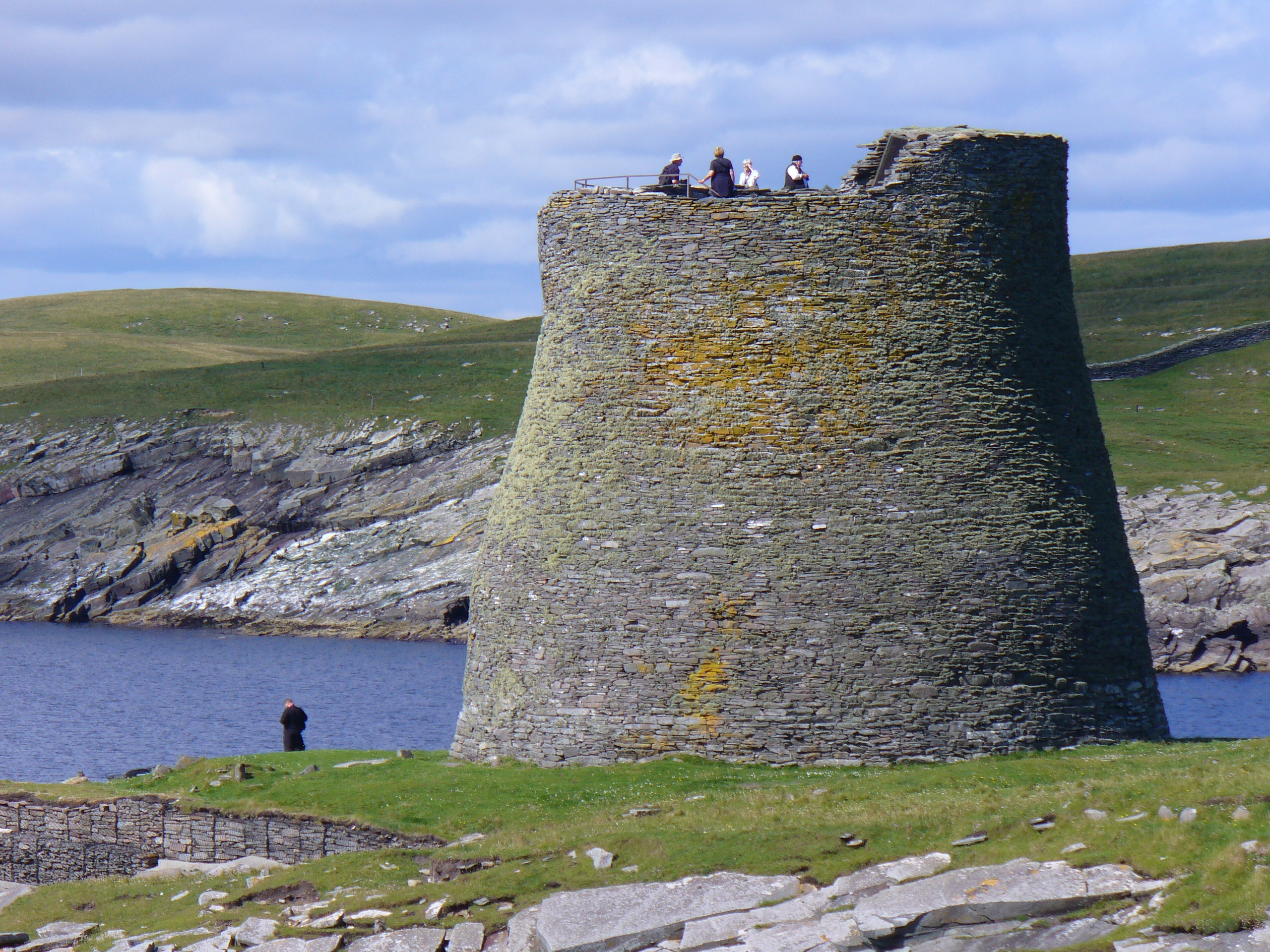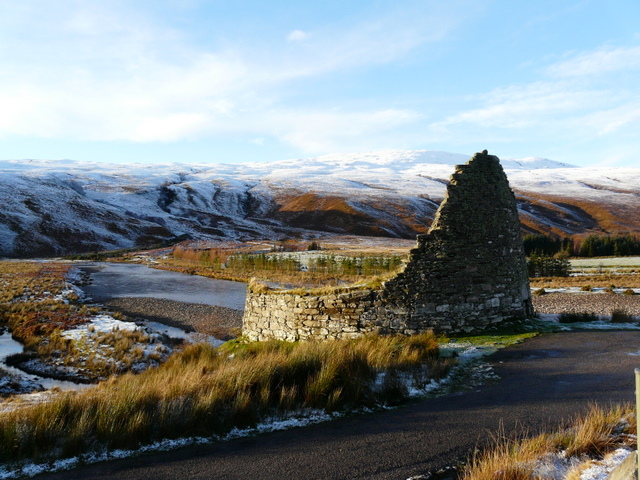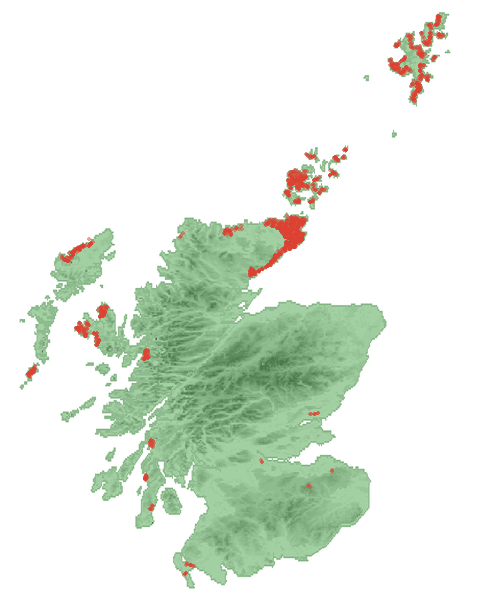|
Dun Dornaigil
Dun Dornaigil is an Iron Age broch in Sutherland in the Scottish Highlands (). It is in Strathmore on the eastern bank of the Strathmore River. It is under the care of Historic Environment Scotland. The interior has been filled and is now inaccessible. Location Dun Dornaigil is located next to the Strathmore River, south of Ben Hope. Under the care of Historic Environment Scotland Historic Environment Scotland (HES) ( gd, Àrainneachd Eachdraidheil Alba) is an executive non-departmental public body responsible for investigating, caring for and promoting Scotland's historic environment. HES was formed in 2015 from the mer ..., it has limited parking space and an information board for visitors. Description The broch has an external diameter of about 14.5 metres. The walls of Dun Dornaigil generally survive from 2 to 3 metres around the circumference of the broch, but above the doorway they rise to nearly 7 metres. The entrance is on the northeast side but is filled with de ... [...More Info...] [...Related Items...] OR: [Wikipedia] [Google] [Baidu] |
Scottish Highlands
The Highlands ( sco, the Hielands; gd, a’ Ghàidhealtachd , 'the place of the Gaels') is a historical region of Scotland. Culturally, the Highlands and the Lowlands diverged from the Late Middle Ages into the modern period, when Lowland Scots replaced Scottish Gaelic throughout most of the Lowlands. The term is also used for the area north and west of the Highland Boundary Fault, although the exact boundaries are not clearly defined, particularly to the east. The Great Glen divides the Grampian Mountains to the southeast from the Northwest Highlands. The Scottish Gaelic name of ' literally means "the place of the Gaels" and traditionally, from a Gaelic-speaking point of view, includes both the Western Isles and the Highlands. The area is very sparsely populated, with many mountain ranges dominating the region, and includes the highest mountain in the British Isles, Ben Nevis. During the 18th and early 19th centuries the population of the Highlands rose to around 300,000, but ... [...More Info...] [...Related Items...] OR: [Wikipedia] [Google] [Baidu] |
Broch
A broch is an Iron Age drystone hollow-walled structure found in Scotland. Brochs belong to the classification "complex Atlantic roundhouse" devised by Scottish archaeologists in the 1980s. Their origin is a matter of some controversy. Origin and definition The word ''broch'' is derived from Lowland Scots 'brough', meaning (among other things) fort. In the mid-19th century Scottish antiquaries called brochs 'burgs', after Old Norse ', with the same meaning. Place names in Scandinavian Scotland such as Burgawater and Burgan show that Old Norse ' is the older word used for these structures in the north. Brochs are often referred to as ''duns'' in the west. Antiquarians began to use the spelling ''broch'' in the 1870s. A precise definition for the word has proved elusive. Brochs are the most spectacular of a complex class of roundhouse buildings found throughout Atlantic Scotland. The Shetland Amenity Trust lists about 120 sites in Shetland as candidate brochs, while the Royal C ... [...More Info...] [...Related Items...] OR: [Wikipedia] [Google] [Baidu] |
British Iron Age
The British Iron Age is a conventional name used in the archaeology of Great Britain, referring to the prehistoric and protohistoric phases of the Iron Age culture of the main island and the smaller islands, typically excluding prehistoric Ireland, which had an independent Iron Age culture of its own. The parallel phase of Irish archaeology is termed the Irish Iron Age. The Iron Age is not an archaeological horizon of common artefacts but is rather a locally-diverse cultural phase. The British Iron Age followed the British Bronze Age and lasted in theory from the first significant use of iron for tools and weapons in Britain to the Romanisation of the southern half of the island. The Romanised culture is termed Roman Britain and is considered to supplant the British Iron Age. The tribes living in Britain during this time are often popularly considered to be part of a broadly-Celtic culture, but in recent years, that has been disputed. At a minimum, "Celtic" is a linguistic ter ... [...More Info...] [...Related Items...] OR: [Wikipedia] [Google] [Baidu] |
Historic Scotland
Historic Scotland ( gd, Alba Aosmhor) was an executive agency of the Scottish Office and later the Scottish Government from 1991 to 2015, responsible for safeguarding Scotland's built heritage, and promoting its understanding and enjoyment. Under the terms of a Bill of the Scottish Parliament published on 3 March 2014, Historic Scotland was dissolved and its functions were transferred to Historic Environment Scotland (HES) on 1 October 2015. HES also took over the functions of the Royal Commission on the Ancient and Historical Monuments of Scotland. Role Historic Scotland was a successor organisation to the Ancient Monuments Division of the Ministry of Works and the Scottish Development Department. It was created as an agency in 1991 and was attached to the Scottish Executive Education Department, which embraces all aspects of the cultural heritage, in May 1999. As part of the Scottish Government, Historic Scotland was directly accountable to the Scottish Ministers. In 2 ... [...More Info...] [...Related Items...] OR: [Wikipedia] [Google] [Baidu] |
Iron Age
The Iron Age is the final epoch of the three-age division of the prehistory and protohistory of humanity. It was preceded by the Stone Age (Paleolithic, Mesolithic, Neolithic) and the Bronze Age (Chalcolithic). The concept has been mostly applied to Iron Age Europe and the Ancient Near East, but also, by analogy, to other parts of the Old World. The duration of the Iron Age varies depending on the region under consideration. It is defined by archaeological convention. The "Iron Age" begins locally when the production of iron or steel has advanced to the point where iron tools and weapons replace their bronze equivalents in common use. In the Ancient Near East, this transition took place in the wake of the Bronze Age collapse, in the 12th century BC. The technology soon spread throughout the Mediterranean Basin region and to South Asia (Iron Age in India) between the 12th and 11th century BC. Its further spread to Central Asia, Eastern Europe, and Central Europe is somewhat dela ... [...More Info...] [...Related Items...] OR: [Wikipedia] [Google] [Baidu] |
Broch
A broch is an Iron Age drystone hollow-walled structure found in Scotland. Brochs belong to the classification "complex Atlantic roundhouse" devised by Scottish archaeologists in the 1980s. Their origin is a matter of some controversy. Origin and definition The word ''broch'' is derived from Lowland Scots 'brough', meaning (among other things) fort. In the mid-19th century Scottish antiquaries called brochs 'burgs', after Old Norse ', with the same meaning. Place names in Scandinavian Scotland such as Burgawater and Burgan show that Old Norse ' is the older word used for these structures in the north. Brochs are often referred to as ''duns'' in the west. Antiquarians began to use the spelling ''broch'' in the 1870s. A precise definition for the word has proved elusive. Brochs are the most spectacular of a complex class of roundhouse buildings found throughout Atlantic Scotland. The Shetland Amenity Trust lists about 120 sites in Shetland as candidate brochs, while the Royal C ... [...More Info...] [...Related Items...] OR: [Wikipedia] [Google] [Baidu] |
Sutherland
Sutherland ( gd, Cataibh) is a historic county, registration county and lieutenancy area in the Highlands of Scotland. Its county town is Dornoch. Sutherland borders Caithness and Moray Firth to the east, Ross-shire and Cromartyshire (later combined into Ross and Cromarty) to the south and the Atlantic to the north and west. Like its southern neighbour Ross-shire, Sutherland has some of the most dramatic scenery in Europe, especially on its western fringe where the mountains meet the sea. These include high sea cliffs, and very old mountains composed of Precambrian and Cambrian rocks. The name ''Sutherland'' dates from the era of Norwegian Viking rule and settlement over much of the Highlands and Islands, under the rule of the jarl of Orkney. Although it contains some of the northernmost land in the island of Great Britain, it was called ' ("southern land") from the standpoint of Orkney and Caithness. In Gaelic, the area is referred to according to its traditional areas: ' ... [...More Info...] [...Related Items...] OR: [Wikipedia] [Google] [Baidu] |
Strathmore, Sutherland
Strathmore or An Srath Mòr is a strath or wide valley in Sutherland in northern Scotland. The strath is in the parish of Durness to the south-east of Loch Eriboll. It runs north–south and has a minor road running alongside the Strathmore River which flows along the valley floor northwards into Loch Hope. Ben Hope is to the east.Anderson.G & Anderson.P (1842) ''Guide to the highlands and islands of Scotland, including Orkney and Zetland'', p.585, Edinburgh: William Taitavailable online. Retrieved 2015-09-29. Strathmore is best known for being the birthplace of the Scottish Gaelic poet, Rob Donn at AultnacaillichFans sing praises of the bawdy bard Rob Donn '' |
Historic Environment Scotland
Historic Environment Scotland (HES) ( gd, Àrainneachd Eachdraidheil Alba) is an executive non-departmental public body responsible for investigating, caring for and promoting Scotland's historic environment. HES was formed in 2015 from the merger of government agency Historic Scotland with the Royal Commission on the Ancient and Historical Monuments of Scotland (RCAHMS). Among other duties, Historic Environment Scotland maintains more than 300 properties of national importance including Edinburgh Castle, Skara Brae and Fort George. History The responsibilities of HES were formerly split between Historic Scotland, a government agency responsible for properties of national importance, and the Royal Commission on the Ancient and Historical Monuments of Scotland (RCAHMS), which collected and managed records about Scotland's historic environment. Under the terms of a Bill of the Scottish Parliament published on 3 March 2014, the pair were dissolved and their functions transferred ... [...More Info...] [...Related Items...] OR: [Wikipedia] [Google] [Baidu] |
Ben Hope
Ben Hope ( gd, Beinn Hòb) is a mountain in northern Scotland. It is the most northerly Munro, standing alone in the Flow Country (a region of bumpy, peat-covered moorland) south-east of Loch Hope in Sutherland. The mountain is a roughly triangular wedge, with a great crag on the west, with two lower shoulders to the south and northeast. Alpine flowers are abundant in season, although the ground is very rocky. Ascent The principal route to the summit starts in Strathmore, to the west of the mountain, where there is parking off a small road. The route lies along the Allt-na-caillich burn which flows down through a gap in the west-facing crags. The route is steep, but well marked with occasional cairns and not exposed. There is little available scrambling. Approach from the east is rare, as there is a wide expanse of heather-covered moorland with no roads in that direction. Approach from the north is not possible for walkers, as there is no path between the crags. The view ... [...More Info...] [...Related Items...] OR: [Wikipedia] [Google] [Baidu] |
Broch Dun Dornaigil's Door Lintel
A broch is an Iron Age drystone hollow-walled structure found in Scotland. Brochs belong to the classification "complex Atlantic roundhouse" devised by Scottish archaeologists in the 1980s. Their origin is a matter of some controversy. Origin and definition The word ''broch'' is derived from Lowland Scots 'brough', meaning (among other things) fort. In the mid-19th century Scottish antiquaries called brochs 'burgs', after Old Norse ', with the same meaning. Place names in Scandinavian Scotland such as Burgawater and Burgan show that Old Norse ' is the older word used for these structures in the north. Brochs are often referred to as ''duns'' in the west. Antiquarians began to use the spelling ''broch'' in the 1870s. A precise definition for the word has proved elusive. Brochs are the most spectacular of a complex class of roundhouse buildings found throughout Atlantic Scotland. The Shetland Amenity Trust lists about 120 sites in Shetland as candidate brochs, while the Royal Co ... [...More Info...] [...Related Items...] OR: [Wikipedia] [Google] [Baidu] |
Lintel
A lintel or lintol is a type of beam (a horizontal structural element) that spans openings such as portals, doors, windows and fireplaces. It can be a decorative architectural element, or a combined ornamented structural item. In the case of windows, the bottom span is instead referred to as a sill, but, unlike a lintel, does not serve to bear a load to ensure the integrity of the wall. Modern day lintels are made using prestressed concrete and are also referred to as beams in beam and block slabs or ribs in rib and block slabs. These prestressed concrete lintels and blocks are components that are packed together and propped to form a suspended floor concrete slab. Structural uses In worldwide architecture of different eras and many cultures, a lintel has been an element of post and lintel construction. Many different building materials have been used for lintels. In classical Western architecture and construction methods, by ''Merriam-Webster'' definition, a lintel is a l ... [...More Info...] [...Related Items...] OR: [Wikipedia] [Google] [Baidu] |







.jpg)

